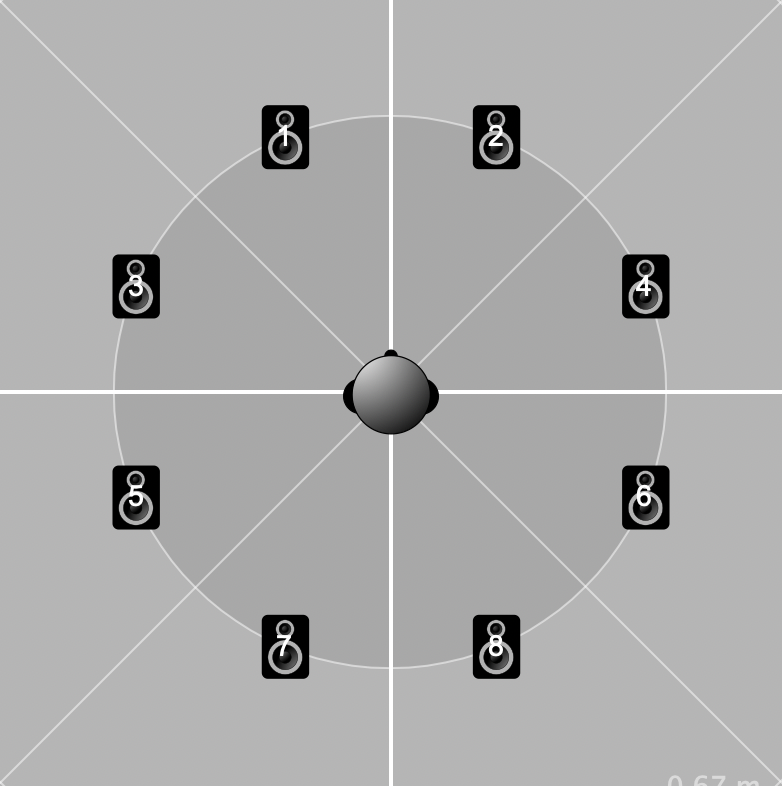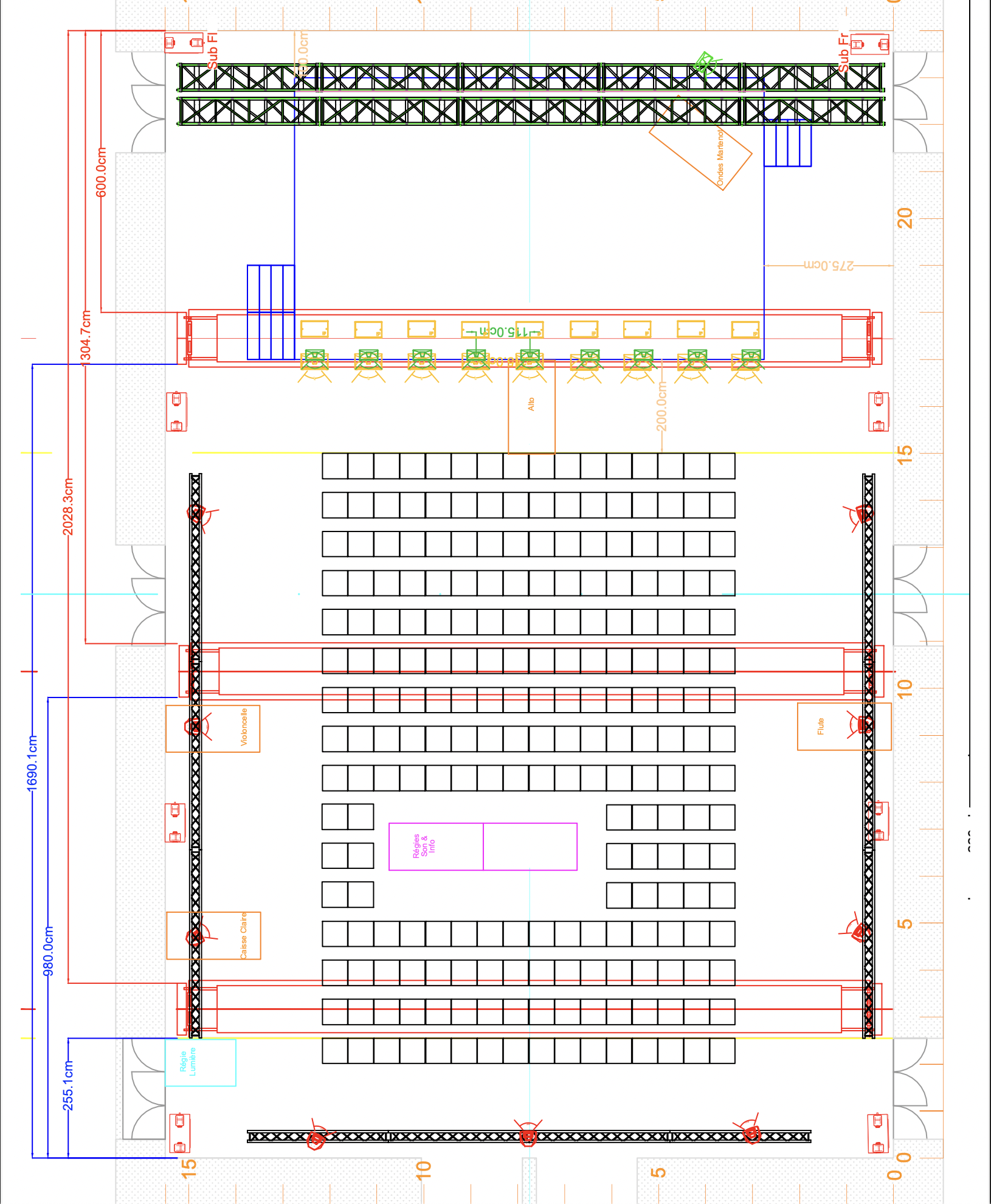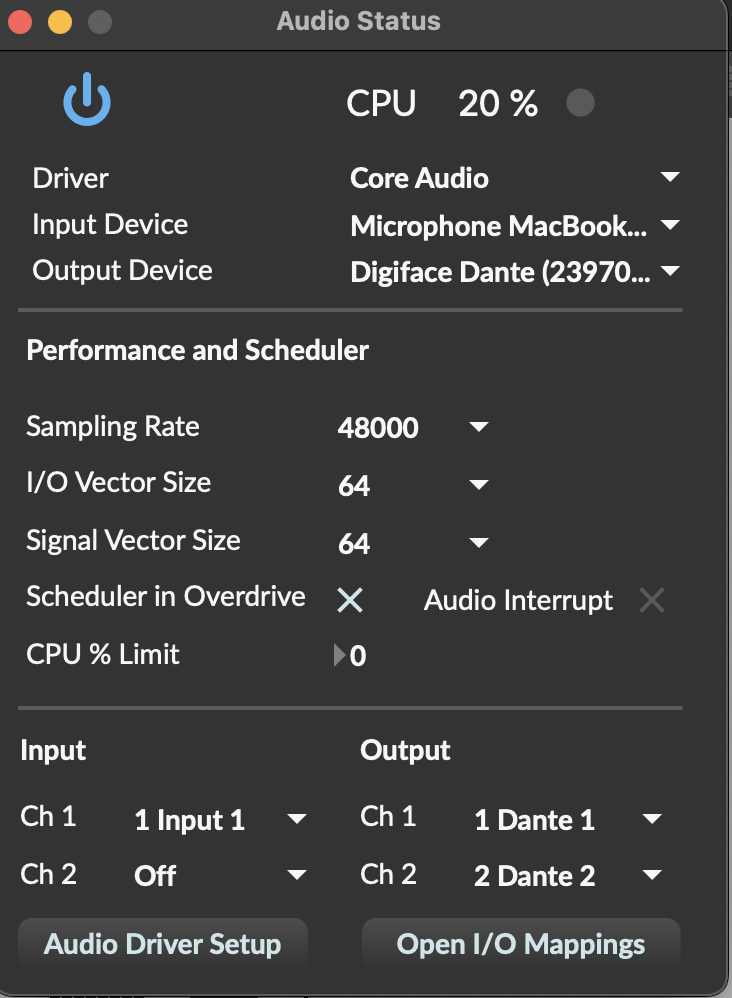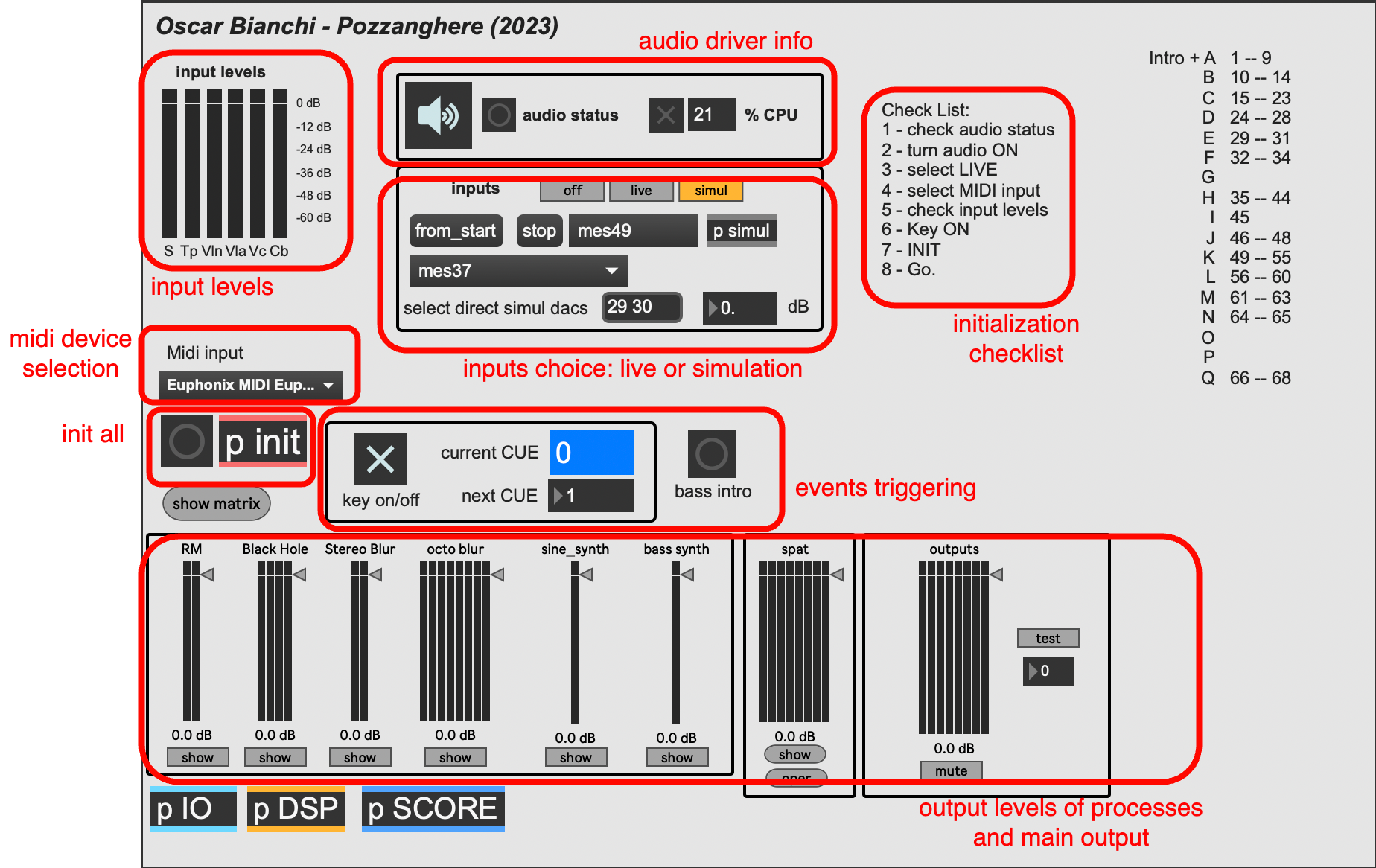Table of contents
- Version documentalist
- Version realisation
- Detailed staff
- Electronic equipment list
- Work related information
- Useful links on Brahms
- Instructions
- Program note
Performance date: 17 novembre 2023 - First performance
Documentation date: 16 janvier 2024
Version state
Valid
Validation date: 15 février 2024
Executions dates of this version
- 17 novembre 2023, Ircam, Espace de projection
Version documentalist
- regnier (regnier@ircam.fr)
Version realisation
- Clément Cerles (Sound engineer)
- Johannes Regnier (Computer Music Designer)
- Oscar Bianchi (Composer)
Version length
25 mnNo other version available
Detailed staff
- soliste : soprano
- trompette, percussionniste, accordéon, piano, violon, alto, violoncelle, contrebasse
Channel details
- Number of input channel : 6
- Number of output channel : 8
Electronic equipment list
Computer Music Equipment
-
1 MacBook Pro - Apple Laptops
(Apple)
Macbook Pro M1 Pro, 32 GB RAM, Mac OS Monterey v. 12.3.1 -
1 Max 8 - Max
(Cycling74)
-
1 Digiface Dante - Sound Board
(RME)
-
1 BCF 2000 - MIDI Mixer
(Behringer)
Audio Equipment
-
2 Microphone - Microphone
1x KMS105 + 1 x DPA4061 for Soprano -
4 Microphone - Microphone
3 x DPA6061 for Viola, Violin, Cello, 1 x DPA4099 for Double Bass -
1 Microphone - Microphone
1 x DPA4099 for Trumpet -
2 Microphone - Microphone
2 x C414 for Accordion L/R -
2 Microphone - Microphone
2 x MKH40 for Piano L/R -
9 Microphone - Microphone
2 x C535 for Vibraphone
2 x C535 for Marimba
1 x C535 for Glockenspiel
1 x DPA4055 for Bass Drum
1 x KM184 for Bell Plates
1 x KM 184 for Springs
1 x DPA2011 for Tom -
1 Contact microphone - Contact Microphones
1 x YamahiKo for Piano
Work related information
Premiere
- 17 novembre 2023, France, Paris, Ircam, Espace de projection, concert des 50 ans de l'Itinéraire
Publisher :
- Durand
Realisation
- Johannes Régnier
Work length
- 25 mn
Useful links on Brahms
- Pozzanghere | Mezzo Seccate pour soprano, huit instruments et électronique (2023), 25mn
- Oscar Bianchi
| File | Author(s) | Comment | |
|---|---|---|---|
| Download [1,5 Gio] | Performance patch Oscar Bianchi_Pozzanghere_v1.dmg | Johannes Regnier | Concert patch , abstractions library, simulation file |
| Download [1,6 Gio] | Other IRCAM Spat library v. 5.3.2 | Spat Library v5.3.2. This is the one used for the performance patch v.1.0. More recent ones should work as well. Adding this version for the sake of completeness. | |
| Download [9,2 Mio] | Score Pozzanghere Full Score with Cues.pdf |
Instructions
1. Audio setup
Requirement: 1 laptop + 1 audio interface with at least 6 inputs/8 outputs.
The concert laptop receives 6 audio channels from the FOH console, and outputs 8 audio channels back to the FOH console.
For the premiere, a RME Digiface DANTE audio interface was used.
Input channels FOH –> ADCs concert laptop:
| input | Max/MSP adc~ | audio interface channel |
|---|---|---|
| 1 | Voice | DANTE 1 |
| 2 | Trumpet | DANTE 2 |
| 3 | Violin | DANTE 3 |
| 4 | Viola | DANTE 4 |
| 5 | Cello | DANTE 5 |
| 6 | Double Bass | DANTE 6 |
Output channels DACs concert laptop –> FOH:
DACs 1 to 8 assigned to loudspeakers ring (loudspeakers 1 to 8)
| output | Max/MSP dac~ | audio interface channel | loudspeaker |
|---|---|---|---|
| 1 | main out 1 | DANTE 1 | LS 1 |
| 2 | main out 2 | DANTE 2 | LS 2 |
| 3 | main out 3 | DANTE 3 | LS 3 |
| 4 | main out 4 | DANTE 4 | LS 4 |
| 5 | main out 5 | DANTE 5 | LS 5 |
| 6 | main out 6 | DANTE 6 | LS 6 |
| 7 | main out 7 | DANTE 7 | LS 7 |
| 8 | main out 8 | DANTE 8 | LS 8 |
2. Loudspeaker setup
The direct sounds of all the instruments and of the soprano are amplified directly via the FOH console, with frontal sound projection.
The laptop outputs 8 channels, to 8 loudspeakers arranged as a ring around the audience.
The arrangement consist of 4 stereo pairs:
1/2 front left / front right
3/4 front side left/ front side right
5/6 back side left/back side right
7/8 back left / back right


Care must be taken to properly balance the direct sound of the live instruments and the processed sound of the electronics, so that they fusion well together.
Subwoofers are necessary for proper reproduction of some electronic processes: they can simply be fed with a mixdown of channels 1 and 2
3. Midi setup
A simple USB MIDI controller is used to control the gain of all the sound processes, as well as the main master output gain. A MIDI controller with 8 faders is required. In the current version (v1.0), the MIDI CC numbers are hardwired to CC81 to CC88. Adapt it accordingly to your own controller in subpatcher [IO]. MIDI channel is 1.
For the premiere, a Behringer BCF2000 was used.
| MIDI CC | Controlled Parameter |
|---|---|
| 81 | Ring modulation output level |
| 82 | Black Hole reverb output level |
| 83 | Stereo spectral blur output level |
| 84 | octophonic spectral blur output level |
| 85 | Sinewaves output level |
| 86 | Bass synth output level |
| 87 | Spat output level (8-ch) |
| 88 | Main output level |
4. Software installation
2 dmg files are needed: Bianchi_Pozzanghere_v1.dmg file (concert patch, library, simulation file), and the Spat library (version 5.3.2).
- Copy both dmg files on your SSD or HD, and mount them.
- Copy their full content in a folder on your HD or SSD.
- Add that folder to the files preferences of Max/MSP (menu Options/File Preferences…), with “subfolders” checked.
a) Max/MSP patches
Open the main concert patch: 00_Pozzanghere_Main_v1.0.maxpat . It should open without errors.
All the required abstractions and gendsp files are in the “lib” subfolder.
b) Routing in Max/MSP
ADC 1 to 6 get the live instruments signals from the FOH console:
1 - Voice
2 - Trumpet
3 - Violin
4 - Viola
5 - Cello
6 - Double Bass
DAC 1 to 8 output to the ring of loudspeakers (LS 1 to 8, via the FOH console)
c) DSP Status Options (Fs, IO vs, S vs, Overdrive, Audio Interrupt, Vector Optimization)
On Apple Silicon: lower vector sizes generally result in lower CPU usage.
For Apple M1/M2/M3, audio settings should be:
48k,64 IOVS, 64 SVS, Overdrive ON, Audio interrupt OFF

5. Patch presentation

a) Notations
N/A
b) Shortcuts
Once the “KEY” toggle is activated:
- space bar: trigger next cue
- right arrow: select next cue (without triggering)
- left arrow: select previous cue (without triggering)
c) Main patch
00_Pozzanghere_Main_v1.0.maxpat
The patch processes the 6 live inputs in real-time.
Here is a quick description of the audio processes:
| Process | #Ins | #Outs | Description |
|---|---|---|---|
| RM | 1 | 2 | A simple ring modulator. Modulator: sine wave. mono in / stereo out |
| Black Hole | 1 | 4 | 4-ch reverberator, with pitch-shifting in the feedback paths. mono in / 4 outs |
| Stereo Blur | 1 | 2 | Stereo spectral blur. mono in / stereo out |
| Octo blur | 1 | 8 | 8-ch spectral blur, with individual delay per channel. mono in / 8 outs |
| Sine synth | N/A | 1 | polyphonic sine synthesizer. mono out. |
| Bass synth | N/A | 1 | Monophonic virtual analog synthesizer. mono out |
| Spat | 8 | 8 | Spatialisateur. 8 sources. 8 speakers. VBAP2D. |
d) Main sub-patches
[IO] : audio inputs/outputs and MIDI inputs
[DSP] : all the audio processes
[SCORE] :electronic score (messages)
[INIT] : main initialization messages
6. Initialization routine
1 - check audio status
2 - turn audio ON
3 - select LIVE inputs
4 - select MIDI input
5 - check input levels
6 - Toggle Key ON
7 - click INIT
8 - good to go.
7. System calibration and tests
Input levels:
Check that the input live signals don’t clip. Average input levels should be around -24 to -18 dBFS.
Gain staging has to be made by the FOH sound engineer on the console. No adjustments have to be made within the patch.
Checking the DAC outputs:
Click the button [test] close to the outputs slider to send a test signal to the 8 DAC outputs.
Simulation:
Select input “simul”.
The simulation consists of an 8-ch audio file corresponding to soprano/Tp/Acc/Vln/Vla/Vc/Cb and the 8th channel for the rest of the ensemble.
These 8 channel are mixdowned and sent unprocessed to the DAC outputs 33 & 34 by default.
This simulates the frontal sound projection of the amplifed instruments and the soprano, unprocessed.
Important – > Choose the DAC outputs for the unprocessed sound of the instruments and the soprano corresponding to your own audio setup during testing.
6 channels of the simulation file (Sp Tp Vln Vla Vc Cb) are sent to the DSP processes, identically to the 6 live inputs in a performance situation.
Adjust the level of the unprocessed mixdown (via the numbox) so that unprocessed sound and processed sounds are roughly equally loud, and are fusioning well.
Click (from start) to play the simulation from the beginning, or select a specific position in the score using the umenu.
For now, the simulation file is only a rough draft rendered from Sibelius + some recordings of the soprano.
8. Performance notes
The piece has a strong dynamic range : it is good to adjust accordingly the levels of the processes, so that the electronics can go from subtle and quiet to loud and rough.
The parts with the Black Hole reverberation should be very subtle, to only add a layer of gentle electronic texture to the instruments.
It is important in section H, measures 158 to 167, to closely follow the dynamic of the live instruments. Make sure to start with the sine fader fully down before triggering the cue #37.
In version 1.0 of the patch, at the very beginning of the piece, a first event has to be triggered independently, on a signal of the conductor, by clicking on “bass intro”. Similarly, at measure 26, the same event should be triggered manually, before entering section A.
For the rest, it simply consists in triggering the cues, and adjusting the levels when necessary.
Program note
_pozzanghere | mezzo seccate_ (flaque d’eau | à moitié à sec) emprunte les mots de son titre, ainsi que l’inspiration de son livret, à _I Limoni_ (Les citrons), qui ouvre le célèbre recueil _Ossi di seppia_ (Os de seiche) du poète et prix Nobel italien Eugenio Montale (1896-1981). Ces trois mots y servent de métaphore au temps qui passe : les flaques d’eau sont évidemment liées au temps, à la météo, et « l’à moitié à sec » renforce le sentiment de la transition, tout en évoquant la nature même de l’eau, qui s’évapore sous l’effet de la chaleur. En italien, le mot « seccate », par sa dureté phonétique même, est puissamment évocateur. Dans l’œuvre de Montale, et particulièrement dans ce poème, son écriture à la fois extrêmement subtile et raffinée témoigne d’un soin infini aux détails, pour décrire le plus souvent la simplicité concrète et sans apprêt du quotidien. Ce déploiement de moyens poétiques pénétrants, cette profondeur sémantique, cette recherche infinie de la langue, mis au service d’une image pure et apparemment banale, constitue un univers qui présente de grandes affinités avec mes idéaux musicaux. _pozzanghere | mezzo seccate_ flirte parfois avec un univers sonore homogène articulé par le quatuor avec contrebasse et l’accordéon qui, en fusionnant, amplifient et dramatisent cet espace du mystère que savent si bien convoquer les instruments à cordes. Par opposition, le piano et la percussion incarnent du concret, le terrestre, le primordial : certains modes de jeu (avec des archets frottés sur les métaux, ou des crins de cheval glissant sur les cordes du piano) génèrent toutefois des éléments de résonance pure, qui transcendent la gravité et l’enracinement dû à leur nature percussive. Posés sur le discours évocateur des cordes et de l’accordéon, ils évoluent ainsi en équilibre entre le concret et l’épure, le tactile et l’éthéré – à l’instar de la poésie de Montale. Ce petit ensemble est l’écrin dans lequel s’inscrivent les deux voix étroitement enlacées de la soprano et de la trompette. Le rôle de la soprano est assez ambigu, voire amphibie : elle est bien sûr la voix, c’est-à-dire cet outil qui exprime langages et désirs, concepts et sentiments, mais elle aussi vecteur abstrait de sons, parfois dénués de sens. Son expressivité peut être lyrique et dramaturgique – donc élaborée, fabriquée selon des codes hérités de l’histoire – mais aussi le résultat d’une impulsion pure, débridée de toute pression sémantique. Soulignant l’ambivalence de la soprano en même temps que libérant son champ d’action, la trompette est tour à tour son ombre ou son reflet (dans la flaque d’eau). Elle joue le jeu trouble du dédoublement et de l’accompagnement, de la tricherie et de l’antithèse : elle est la némésis de la voix, offrant sa propre version du discours, plus abstraite et insaisissable. Se déployant telle un continuum, cette pièce est en quête d’un nouveau paradigme relationnel entre la voix et l’ensemble instrumental : jusqu’où peut-on aller, que peut-on raconter, donner à vivre, via la voix ? Comment la voix ouvre-t-elle l’écoute vers d’autres perceptions d’elle-même – au-delà du sémantique ou du lyrique ? Comment peut-elle nous éclairer, nous aider à avancer à l’intérieur de nous-mêmes, à vivre subjectivement cette expérience du son, cette expérience sonore, comme un voyage intérieur plutôt qu’un voyage d’observation ?Oscar Bianchi, note de programme du concert des 50 ans de l'Itinéraire à l'Espace de projection de l'Ircam le 17 novembre 2023.
Version documentation creation date: 16 janvier 2024 17:19, update date: 15 février 2024 15:31